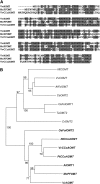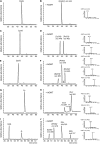A novel cation-dependent O-methyltransferase involved in anthocyanin methylation in grapevine
- PMID: 19525322
- PMCID: PMC2719152
- DOI: 10.1104/pp.109.140376
A novel cation-dependent O-methyltransferase involved in anthocyanin methylation in grapevine
Abstract
Anthocyanins are major pigments in colored grape (Vitis vinifera) berries, and most of them are monomethoxylated or dimethoxylated. We report here the functional characterization of an anthocyanin O-methyltransferase (AOMT) from grapevine. The expression pattern in two cultivars with different anthocyanin methylation profiles (Syrah and Nebbiolo) showed a peak at start ripening (véraison), when the concentrations of all methylated anthocyanins begin to increase. The purified recombinant AOMT protein was active on both anthocyanins and flavonols in vitro, with K(m) in the micromolar range, and was dependent on divalent cations for activity. AOMT showed a preference for 3',5' methylation when a 3',4',5' hydroxylated anthocyanin substrate was tested. In order to assess its in planta activity, we performed transient expression of AOMT in tobacco (Nicotiana benthamiana) leaves expressing the Production of Anthocyanin Pigment1 (PAP1) transcription factor from Arabidopsis (Arabidopsis thaliana). PAP1 expression in leaves induced the accumulation of the nonmethylated anthocyanin delphinidin 3-rutinoside. The coexpression of PAP1 and AOMT resulted in an accumulation of malvidin 3-rutinoside. We also showed that AOMT localized exclusively in the cytoplasm of tobacco leaf cells. These results demonstrate the ability of this enzyme to methylate anthocyanins both in vitro and in vivo, indicating that AOMT plays a major role in anthocyanin biosynthesis in grape berries.
Figures







References
-
- Ageorges A, Fernandez L, Vialet S, Merdinoglu D, Terrier N, Romieu C (2006) Four specific isogenes of the anthocyanin metabolic pathway are systematically co-expressed with the red colour of grape berries. Plant Sci 170 372–383
-
- Andersen O, Markham KR (2006) Flavonoids: Chemistry, Biochemistry and Applications. CRC Press, Boca Raton, FL
-
- Awika JM, Rooney LW, Waniska R (2004) Properties of 3-deoxyanthocyanins from sorghum. J Agric Food Chem 52 4388–4394 - PubMed
-
- Bailly C, Cormier F, Do CB (1997) Characterization and activities of S-adenosyl-L-methionine:cyanidin 3-glucoside 3′-O-methyltransferase in relation to anthocyanin accumulation in Vitis vinifera cell suspension cultures. Plant Sci 122 81–89
Publication types
MeSH terms
Substances
Associated data
- Actions
LinkOut - more resources
Full Text Sources
Other Literature Sources
Molecular Biology Databases

